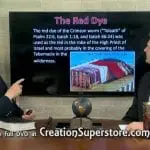The Day-Day View: A Criticism Answered
| by | Wayne Jackson, M.A. |
What is the “Day-Day” view? It is the view that considers the “days” of the creation week in Genesis 1 as exactly what the text implies—literal days of approximately twenty-four hours each. It is, therefore, the antithesis of the Day-Age Theory, which has enjoyed sustained popularity among some scholars.
Generally, the Day-Age Theory is not defended by an appeal to the biblical text. Rather, its advocates usually claim, more often than not, that there is “scientific evidence” for a much older Earth than a literal reading of the Scriptures would indicate. Therefore, the assumption is made that the “days” of Genesis 1 cannot be interpreted literally. Recently, however, attempts have been made to argue for the Day-Age concept by an appeal to the Genesis narrative itself. The argument runs as follows: (1) There is textual evidence in Genesis 2 that the sixth day of the creation week could not have been a literal day; (2) But obviously it was the same type of “day” as the previous five; (3) Thus, none of the “days” of the creation week is to be seen as literal.
What, though, is the “evidence” that would indicate the sixth day of creation was not a literal day? The reply is two-fold: (1) First, it is said that after God created Adam on the sixth day, He commissioned him to name all of the animals before Eve was fashioned later on the same “day,” and this would have involved a much longer period than a mere twenty-four hour day. (2) Second, it is alleged that when Adam first saw Eve, he said, “This is now bone of my bones…,” and his statement reflects that he had been some time without a mate—certainly longer than a few hours. Let us give due consideration to each of these matters.
The foregoing compromise of the clear biblical record is presented in Gleason L. Archer’s book, Encyclopedia of Bible Difficulties (1982, pp. 58-65). Significantly, professor Archer revealed that he has been influenced by the assertions of evolutionary geochronology. His discussion of this matter is in response to the question: “How can Genesis 1 be reconciled with the immense periods of time indicated by fossil strata?” He claimed that there is a conflict between Genesis and the beliefs of evolutionary geologists only if one understands “Genesis 1 in a completely literal fashion,” which, he asserted, is unnecessary. Archer has suggested that God then “…gave Adam a major assignment in natural history. He was to classify every species of animal and bird found in the preserve” (1982, p. 59). Dr. Archer said that it
…must have taken a good deal of study for Adam to examine each specimen and decide on an appropriate name for it, especially in view of the fact that he had absolutely no human tradition behind him, so far as nomenclature was concerned. It must have required some years, or, at the very least, a considerable number of months for him to complete this comprehensive inventory of all the birds, beasts, and insects that populated the Garden of Eden (1982, p. 60).
One would be hard pressed to find a better example of “the theory becoming father to the exegesis” than this. Archer simply has “read into” the divine narrative the assumptions of his erroneous view. Let us take a careful look at the Bible facts.
First, apparently only those animals that God “brought” unto Adam were involved, and this seems to be limited, as even Archer has conceded, to Eden. Second, certain creatures were excluded. There is, for example, no mention of fish or creeping things. Third, the text does not suggest how broad the categories were that Adam was to name. It is sheer assertion to claim that he was to name all “species.” God created living organisms according to “kinds” which, in the Bible, appears to be a rather elastic term. It translates the Hebrew word, min, which sometimes seems to indicate species, sometimes genus, and sometimes family or order. [But, as Walter C. Kaiser, Chairman of the Department of Old Testament and Semitic Languages, Trinity Divinity School, has observed: “This gives no support to the classical evolutionist view which requires developments across kingdom, phyla, and classes” (as quoted in Harris et al., 1980, 1:504).] Fourth, why should it be assumed that Adam had to “give a good deal of study” to this situation? He never had to “study” walking or talking; clearly Adam had been miraculously endowed with a mature knowledge that enabled him to make his way in that antique environment. He needed no “human tradition” behind him; he was “of God” (Luke 3:38).
Keil and Delitzsch, in their commentary on Genesis, observed that Adam and Eve were created on the same day, “…and there is no difficulty in this, since it would not have required much time to bring the animals to Adam to see what he would call them, as the animals of paradise are all we have to think of ” (1978, 1:87). H.C. Leupold remarked:
That there is a limitation of the number of creatures brought before man is made apparent by two things. In the first place, the beasts are described as beasts of the field (hassadheh), not beasts of the earth, as in 1:24. Though there is difficulty in determining the exact limits of the term “field” in this instance, there is great likelihood (Cf.: also v. 5) that it may refer to the garden only. In the second place, the fish of the sea are left out, also in v. 20, as being less near to man. To this we are inclined to add a third consideration, the fact, namely, that the garden could hardly have been a garden at all if all creatures could have overrun it unimpeded. Since then, very likely, only a limited number of creatures are named, the other difficulty falls away, namely, that man could hardly have named all creatures in the course of a day (1975, pp. 130-131).
Henry Morris has commented:
We have no way of knowing exactly how many “kinds” of animals appeared before Adam, but it was clearly not such a large number as to be incapable of examination within a few hours at most. It is not unreasonable to suggest that Adam could note and name about ten kinds each minute, so that in, say five hours, about three thousand kinds could be identified. Clearly, this number seems more than adequate to meet the needs of the case (1976, p. 97).
Archer’s argument about the animals is, therefore, much ado about nothing. Further, Archer has suggested that the naming the animals left Adam with a “long and unsatisfying experience as a lonely bachelor” and so he was “emotionally prepared” when Eve was formed (1982, p. 60). Another writer declared: “It seems that he [Adam—WJ] had been searching diligently for a long time for a suitable mate, and when he found her, he burst out, This at last [literally, ‘this time’] is bone of my bones, etc.” (Willis, 1979, p. 113.).
Again, one can only express amazement at how some scholars so adroitly “read between the lines.” There is nothing in the statement, “This is now bone of my bones…” that demands a long, lonely, searching bachelorhood for Adam. The Hebrew word translated “now” is pa’am. The term does not require a protracted span of time, as asserted by Willis. It can denote simply a contrast with that which is previously recorded, as it obviously does in this context. Professor M.W. Jacobus observed that the term denotes “this time—in this instance, referring to the other pairs,” and so it simply expressed Adam’s satisfaction with his mate in contrast to the animals he had been naming (1864, p. 110). Or, as Jamieson commented:
…this time, is emphatic (Cf.: 30:30; 46:30). It signifies “now indeed,” “now at last,” as if his memory had been rapidly recalling the successive disappointments he had met with in not finding, admidst all the living creatures presented to him, any one capable of being a suitable companion to him (1945, 1:46).
There is, therefore, nothing in Genesis 2 that is in conflict with the plain, historical, literal statement of Genesis 1:27ff.: “And God created man in his own image, in the image of God created he him; male and female created he them…. And there was evening and there was morning, the sixth day.” As we have pointed out repeatedly, the Scriptures indicate that the creation week of six days was composed of the same kind of “days” that the Hebrews employed in the observance of the Sabbath (cf. Exodus 20:8-11). Although this point has been ridiculed, it never has been answered.
There is another point, from the New Testament, that is worthy of consideration. In 1 Timothy 2:13, Paul stated: “For Adam was first formed, then Eve.” Of special interest here is the word “then” (Greek, eita). This term is an adverb of time meaning “then; next; after that” (Thayer, 1958, p. 188). It is found thirteen times in the New Testament in this sense. [Once it is employed in argumentation to add a new reason and so is rendered “furthermore” (Hebrews 12:9).] The word, therefore, generally is used to suggest a logical sequence between two occurrences: there is never an indication that a long lapse of time separates the two. Note the following:
- Jesus “girded himself. Then (eita) he poureth water into the basin…” (John 13:5).
- From the cross, to Mary, Jesus said, “Woman, behold thy son! Then (eita) saith he to the disciple…” (John 19:26-27). Compare also John 20:27: “Then (eita) saith he to Thomas….” See also Mark 8:25.
- In Luke 8:12, some seed fell by the wayside, “then (eita) cometh the devil and taketh away the word from their heart.” Note Mark’s parallel: “Straightway cometh Satan, and taketh away the word…” (4:15). These examples reveal no long lapses of time.
- James stated a man “is tempted when he is drawn away by his own lust, and enticed. Then (eita) the lust, when it hath conceived, beareth sin…” (1:14-15). How long does that take?
- Christ appeared to Cephas, “then (eita) to the twelve” (1 Corinthians 15:5), and this was on the same day (Luke 24:34-36). See also 1 Corinthians 15:7.
- In speaking of Christ’s coming, Paul declared: “Then (eita) cometh the end” (1 Corinthians 15:23-24). Will there be a long span of time between Christ’s coming and the end? Indeed not (see Jackson, n.d.).
- For the two other uses of eita, see Mark 4:28 and 1 Timothy 3: 10. And so, “Adam was first formed, then (eita) Eve” (1 Timothy 2:13). Paul’s use of this adverb, as compared with similar New Testament usages elsewhere, is perfectly consistent with the affirmation of Moses that Adam and Eve were made on the same literal day of history. The specious arguments that would accommodate Genesis to the unscriptural (and unscientific) views of modern evolutionism are shown to be totally false.
Archer, Gleason L. (1982), Encyclopedia of Bible Difficulties (Grand Rapids, MI: Zondervan).
Harris, R.L. G.L. Archer, and B.K. Waltke (1980), Theological Wordbook of the Old Testament(Chicago, IL: Moody).
Jackson, Wayne (no date), Premillennialism—A System of Infidelity (Stockton, CA: Courier Publications).
Jacobus, M.W. (1864), Notes on Genesis (Philadelphia, PA: Presbyterian Board of Publication).
Jamieson, Robert (1945), Jamieson, Faucett, Brown Bible Commentary (Grand Rapids, MI: Eerdmans).
Keil, C.F. and F. Delitzsch (1978 reprint), Commentary on the Old Testament (Grand Rapids, MI: Eerdmans).
Leupold, H.C. (1975 reprint), Exposition of Genesis (Grand Rapids, MI: Baker).
Morris, Henry M. (1976), The Genesis Record (Grand Rapids, MI: Baker).
Thayer, J.H. (1958 reprint), Greek-English Lexicon of the New Testament (Edinburgh, Scotland: T. & T. Clark).
Willis, John T. (1979), Genesis (Austin, TX: Sweet).
Originally published in Reason & Revelation, October 1982, 2[10]:41-43. Copyright © 1982 Apologetics Press, Inc. All rights reserved.
We are happy to grant permission for items in the “Creation Vs. Evolution” section to be reproduced in part or in their entirety, as long as the following stipulations are observed: (1) Apologetics Press must be designated as the original publisher; (2) the specific Apologetics Press Web site URL must be noted; (3) the author’s name must remain attached to the materials; (4) textual alterations of any kind are strictly forbidden; (5) Some illustrations (e.g., photographs, charts, graphics, etc.) are not the intellectual property of Apologetics Press and as such cannot be reproduced from our site without consent from the person or organization that maintains those intellectual rights; (6) serialization of written material (e.g., running an article in several parts) is permitted, as long as the whole of the material is made available, without editing, in a reasonable length of time; (7) articles, excepting brief quotations, may not be offered for sale or included in items offered for sale; and (8) articles may be reproduced in electronic form for posting on Web sites pending they are not edited or altered from their original content and that credit is given to Apologetics Press, including the web location from which the articles were taken.
For catalog, samples, or further information, contact:
Apologetics Press
230 Landmark Drive
Montgomery, Alabama 36117
U.S.A.
Phone (334) 272-8558
http://www.apologeticspress.org
Image credit: Greek icon from Meteora
Read more from Apologetics Press in the Book:
Science VS Evolution: Where does the evidence lead?
In Science VS Evolution Dr. Jeff Miller, has completed a lengthy analysis in which he methodically examines the laws of science and their implications regarding naturalistic evolution. Discovering fundamental flaws in five of the central tenets of evolution, Dr. Jeff sets forth modern scientific evidence that decisively refutes evolution. In the process, the evidence strongly supports biblical Creation and the existence of God . . .










1 simple ? If sin & death didn’t enter into the world until AFTER Adam & Eve sinned, then how can evolution be part it or how can God call death good before hand as He did at conclusion of Creation???? By the way, God who created time, does need it to create millions of years to accomplish His Will!!! The false theory of evo.union does!💩